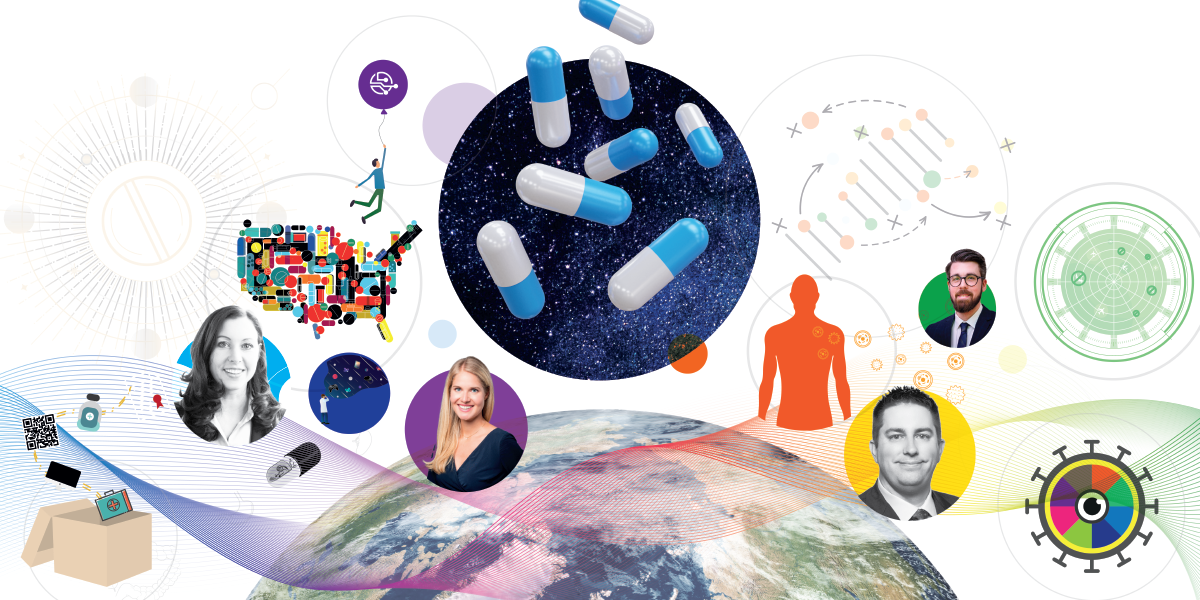The Multifaceted Future of Pharma – Chapter 3: A World of AI, Data, and Automation
In Chapter 3, expert predictions turn to AI and machine learning, and how these technologies can bring added efficiency to the factory floor.
From advanced analytics and screening to setting new standards in quality and productivity, pharmaceutical manufacturing experts share their thoughts on how the use of AI, ML and other digital and automated technologies will transform drug development and manufacture.
What we asked: “Looking ahead to the next 5–10 years, what will be the key disruptors and/or what can be improved upon in the pharma industry?”

“One of the primary reasons that many of us – myself included – embarked on a career in the pharma industry was to help people. Whether for a mild ailment or a debilitating disease, medicines are one tangible way that we can help relieve a patient’s suffering. However, in my 25 plus years in this industry, we have not seen a significant change in the time that it takes to get a new drug to market; the timeline from discovery through commercial launch is still in the 10-15 year range. While some medicines receive accelerated approval via fast-track, orphan, or breakthrough status to serve unmet medical needs, in general, patients in need must wait entirely too long for them to come to market.
“In the next ten years, I hope to see a reduction in the time it takes to get a new medicine to market, and I believe that the application of AI and ML in all areas of drug development represents our best hope for shortening the average to under 10 years. A few of the ways AI/ML tools can make a material impact on the time it takes to get a new drug to market include:
- Analyzing large biological datasets to identify potential drug targets more quickly and accurately than traditional methods.
- Generating and screening millions of potential drug compounds; predicting their properties and efficacy before entering the lab testing phase; and predicting a drug's toxicity, side effects, and interactions, potentially reducing the need for extensive animal testing.
- Analyzing patient data to identify ideal candidates for clinical trials; optimizing clinical trial protocols and analyzing results more efficiently.
- Identifying new uses for existing drugs by analyzing mechanisms of action and potential effects on different diseases.
- Using data to improve drug manufacturing processes, potentially reducing costs and increasing efficiency
“We’ve seen how ML can significantly reduce the time it takes to realize a scalable manufacturing process. While AI is unlikely to reduce the lengthy clinical trial and regulatory review phase in the near term – and as tools improve and become more integrated into all stages of drug development – the cumulative impact could become more significant over time.
“We have only scratched the surface when it comes to AI and ML applications in the drug development and manufacturing process. I’m energized by the possibilities that we can uncover for accelerating change in the next decade and beyond.”

“The continued advancement of AI has the potential to dramatically change the biopharma industry. Though still in its nascent phase, AI not only offers the opportunity to augment some of the most exciting breakthrough science, but also introduces significant productivity enhancements, which our industry desperately needs.
“Many companies are exploring ways to harness the power of generative AI to potentially reduce the time and increase the efficiency of developing and delivering much-needed medicines. Within Insmed, some initial applications include expediting the identification of potential therapeutic candidates for early-stage pipelines, producing initial drafts of clinical study reports and other labor-intensive regulatory documents, and helping to sift through large quantities of scientific literature, as well as internal enterprise data.
“There are countless ways to potentially leverage AI to deliver tangible improvements in our industry. Companies are starting to explore this space, and we’re all rooting for each other to succeed because of the tremendous implications it could have for the entire life sciences ecosystem – and for patients!”
“AI and machine learning are set to change and restructure the industry as we know it – but we must jump the implementation barrier first. This will rely on gaining access to extensive data sets, which means prioritizing data collection, management, and analysis to facilitate real-time decision-making across all corners of our practice.
“There is also an expectation for improved biosensor technology to analyze crucial parameters – including glucose, lactate, oxygen, CO2, and pH – as the industry progresses towards next-generation manufacturing. While current processes are conducted in modular unit operations, enhanced integration will be necessary.”

“With the reliance on digitalization in all phases of drug development, including discovery, formulation, clinical trials, scale-up, manufacturing, and supply chain, there is a significant opportunity for enhanced efficiency and quality throughout the entire value chain. This includes better product discovery and design, optimization of products and manufacturing processes, and reduced time to market, all while mitigating risks and reducing costs.
“Furthermore, there is an increasing need to share data among research organizations, pharma companies, CDMOs, and suppliers. This shared data could include models of unit operations, raw material data, and the implementation of process analytical technologies. The use of ‘big data’ can also significantly fuel AI, further enhancing the efficiency and effectiveness within the industry.
“By increasing collaboration on these digital initiatives, we could see a dramatic improvement in operational efficiency throughout the pharmaceutical industry in the years to come.”

“According to the FDA's fiscal year 2023 report on the State of Pharmaceutical Quality, the agency significantly increased its regulatory scrutiny from 2022 to 2023, raising the number of inspections by 42 percent. This was largely a result of maintaining high standards and compliance across all manufacturing sites, regardless of location. But why does it matter? More regulatory inspections mean more pressure on the pharma industry to be perpetually audit ready. That’s one of the areas where Pharma 4.0 comes into play.
“While there may be resistance to change within the industry, embracing enterprise-wide digitization and automation will be crucial in improving productivity and compliance. These areas will be the future of pharma, providing access to data and insights, and allowing for faster real-time decision-making and, ideally, leading to right-first-time manufacturing.
“The pharma companies that choose to embrace innovative software, advanced robotics, and AI technology will be ready anytime a regulator shows up at their front door, as well as have the insights to optimize their operations, reducing cost, improving throughput and increasing sustainability. But each of these must be adopted enterprise-wide and across the manufacturing value stream for the industry to really experience the full benefits of pharma 4.0.”

“Over the past few years, AI has been one of the most sought-after technologies of interest by an array of industries, and investment is underway to evaluate its applications. Innovations brought about by AI and ML are nothing short of spectacular.
“Solutions based on AI algorithms are finding applications in many areas. A recent study by Yale, surveying 200 chief executives, revealed that nearly half (48 percent) see healthcare as the primary sector to undergo major changes because of AI advancements. Across industries, 73 percent of US companies have already adopted AI in at least some areas of their business, according to a 2023 Emerging Technology Survey conducted by PwC – and generative AI (GenAI) is leading the way. In 2024, AI will start to fundamentally change how business gets done. It will impact how companies grow revenue, conduct everyday operations, engage customers and employees, build new business models and more. This means that the right AI choices could provide companies with a significant edge.
“In fact, with the increasing pace and complexity of drug discovery, coupled with rising costs and supply chain challenges, adoption of AI will become a critical imperative for successfully navigating the demanding landscape. The rapid adoption of AI is compelling, given its ability to transform vast amounts of information into actionable insights and its synergy with advancements in data-driven technologies. Furthermore, as the volume of data generated in the industry continues to expand, the capacity of AI to effectively analyze and utilize this information for strategic decision-making becomes increasingly crucial.
“AI in pharma will continue to gain momentum. There are a growing number of pharmaceutical companies considering – or already using – AI-based solutions in research and drug discovery, optimization of drug substance synthesis, formulation and process development, quality control, predictive maintenance, clinical trial data analytics, pharmacovigilance, patient support, dosage control, ongoing post-market research and analysis of treatment results, inventory and supply chain management, as well as many additional areas.”

“There are exciting times ahead for the life science industry, with the emergence of Pharma 5.0 and the rapidly evolving digital environment in which we all live and operate. When used properly and monitored appropriately, AI is a useful tool that promises to accelerate drug discovery, personalize treatments, improve patient outcomes, reduce costs, and contribute to supply chain optimization.
“Likewise, advanced techniques such as continuous manufacturing, machine learning and 3D printing could improve operational efficiency, make the production lines of the future more agile, and facilitate the introduction of genuinely personalized medicines. Certainly, challenges such as data privacy, regulatory compliance, and a full understanding – and acceptance – of the algorithms being used need to be addressed, but the potential benefits are huge.
“Combined, all these elements of Pharma 5.0 represent a shift in pharmaceutical manufacturing, paving the way for a future in which medications are developed faster, customized to individual patient needs and delivered with uncompromising quality.
“It's not just about innovation; it’s about transforming the way we think about healthcare and ultimately improving the lives of patients around the world. As users, we must put measures and controls in place and acknowledge that the next steps in our own human development may come with some digital assistance.”

“For me, the emergence of cell and gene therapies stands out as a particularly transformative moment in the pharma industry. In the future, we will see dramatic improvements in this field thanks to digitalization and automation.
“The fact that the cell is the product is a unique feature of cell therapies. This necessitates comprehensive characterization of the production process and an in-depth understanding of the impact of this process on the characteristics of the cells. A major challenge, and potential solution, is the wealth of information and comparison options scientists have in the laboratory, including data on bioprocess parameters, cell growth and viability, and cell characteristics. To leverage these and remain competitive, companies in the pharmaceutical and drug development sector must adapt by embracing digital products and services.
“The contextualization of data in and around value-adding core processes, such as upstream cultivation or cell analysis, will be a major impetus to dramatically improve and propel our industry to improve. Contextualization requires data harmonization, which standardizes disparate data sets, making them easier to integrate and analyze. Harmonized data also ensures that the information submitted to regulatory bodies is consistent and reliable.
“Faster adoption of state-of-the-art technologies that simplify data harmonization and contextualization, and certain communication standards, will lead us to the much-needed and desired improvements of data usage. This will help gain deeper process insights based on advanced process modeling and AI applications, better collaboration among scientists, institutions, pharmaceutical companies, and suppliers, and – in the end – contribute to improved human living conditions.”

“The life sciences industry has been waiting a long time for big data to transform the commercial viability of personalized medicine. With intelligent automation and robotic process automation now coming of age, R&D teams can finally seize the opportunity — as long as their big data is also clean, standardized, interoperable, and secure. Looking ahead, companies will maintain focus on making big data more usable by resolving common pain points around cleaning, ownership, and standards. As a result, the volume and frequency of access to study data will increase exponentially. This will require a transparent data model with stringent user access controls to address data privacy and cyber-security concerns.
“Pharma companies will also use automation to make efficiency gains across the development lifecycle, whether deep querying protocols, detecting patterns during medical imaging analysis, or verifying the origin of chemical components. Increasingly, this will lead to direct data APIs between sponsors, health institutes, and regulatory authorities so that “big (clean) data” becomes a reality, creating the right conditions for commercially viable, personalized medicines to reach patients in need.”

“Biopharma 4.0, which has focused on digital transformation within the pharma/biopharma industry over the past decade, is well underway. In silico tools are transforming drug development at every stage and we are seeing small molecule drugs being discovered using generative AI even faster. It has been just over a year since we saw the first fully generative AI-created drug enter human trials (Insilico Medicine’s INS018_055) and the excitement about AI and its potential has far from waned.
“Physicochemical properties of novel NCEs can be predicted from their structure to help inform candidate selection before generating experimental data. Such tools are not limited to small molecular weight drugs, as it is now possible to predict protein structure and function from its sequence of amino acids. In early development, physiologically based pharmacokinetic and pharmacokinetic/pharmacodynamic models can be continually refined as data becomes available to support decision making and maximize the chances of clinical success. In manufacturing, digital twins are increasingly used to de-risk and remove waste (e.g. time and cost) from processes for enhanced process control and improved product quality.
“If the last few years indicate what the future will hold, I anticipate AI and ML continuing their explosive path, impacting every stage of drug development. The continual linkages that we can build between AI and other in silico tools will lead to tremendous improvements in productivity across our industry, advancing the next frontier of medicines.”